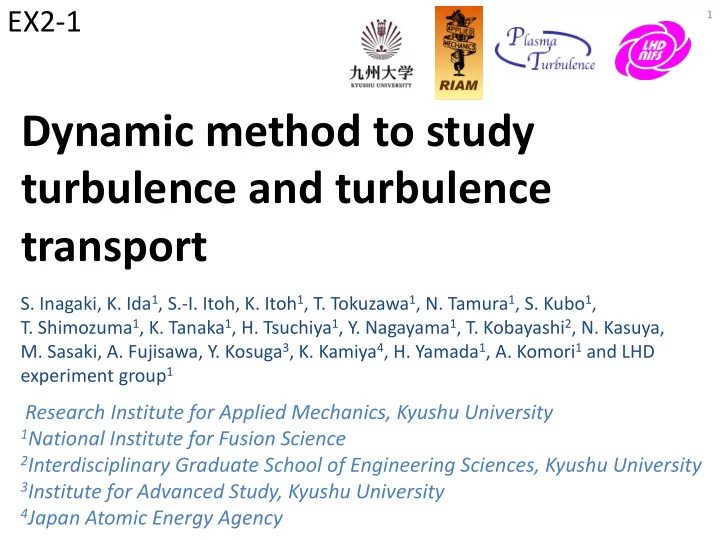

EX2-1 1 Dynamic method to study turbulence and turbulence transport S. Inagaki, K. Ida 1 , S.-I. Itoh, K. Itoh 1 , T. Tokuzawa 1 , N. Tamura 1 , S. Kubo 1 , T. Shimozuma 1 , K. Tanaka 1 , H. Tsuchiya 1 , Y. Nagayama 1 , T. Kobayashi 2 , N. Kasuya, M. Sasaki, A. Fujisawa, Y. Kosuga 3 , K. Kamiya 4 , H. Yamada 1 , A. Komori 1 and LHD experiment group 1 Research Institute for Applied Mechanics, Kyushu University 1 National Institute for Fusion Science 2 Interdisciplinary Graduate School of Engineering Sciences, Kyushu University 3 Institute for Advanced Study, Kyushu University 4 Japan Atomic Energy Agency
2 Revisiting heat pulse propagation analysis Discovery of the New Transport Relation on LHD Conventional method has Conventional Approach serious difficulty q q c c e e hp pb n T n T Periodic power modulation e e e e q e Lopes Cardozo PPCF 1995 n e Pulse Propagation c pb S. Ingaki NF 2013 c hp T e Multiple-Valued Function Single-Valued Function ( hysteresis) One time-scale Two time-scales
Contents 3 Method to study turbulence transport - Assessment of conventional method (What is c hp ?). - A simplified new approach to understand the transport with multiple-valued flux (hysteresis, barrier formation) Method to observe multi-scale couplings of turbulence - Observation of coupling of micro-fluctuations at distant locations
4 Exp. Set-up and Conditional Averaging MECH 25Hz - Target plasma (NBI+MECH) - Modulations of T e , ∇ T e and fluctuation are observed simultaneously Macro-mode no ITB, no ETB Micro-fluctuations S. Ingaki NF 2013 Periodic temporal evolution of no evidence of high-energy tail signals are precisely extracted.
Precise spatiotemporal structure of heat pulse 5 Conditional averaging technique is very powerful tool Diffusive Nature Experiment Simulation one time scale two distinct time scales The conventional c hp is flawed since it neglects two time scales in transient response.
6 Higher harmonics in the heat pulse propagation The two-time scale feature should appear in the response of extremely-higher harmonics (Conditional Averaged) More-than 10th harmonics are observed even far away from source
7 Features of Higher harmonics Weaker decay in amplitude Faster propagation 1st 3rd 5th Diffusion ¶ A ¶ r ~ ¶ Q 1 ¶ r µ m Observations far from diffusive nature A
8 Higher harmonics in the heat pulse propagation Fundamental mode can not catch the response around turn-on/off of ECH power where q e changes discontinuously To describe a discontinuous function, higher harmonics is essential Higher harmonics should be more routinely checked to clarify the transport with multiple-valued flux
9 Heat pulse propagation during ITB transition - ECH modulation experiment near the ITB transition - The ITB foot shifts back and forth during ECH modulation foot Similar to K. Ida NF 2009 Delayed rises and simultaneous drops are observed
10 Mixed time-scale phenomena - Three or four dynamics combined - Fast propagation, Displacement of ITB front, D Global (non-local) response in T e (Conditional Averaged) d T e d T e d T e /(d T e ) max D D D Fast D Propagation T e drop Global responses ITB transition is involved with multi-mechanisms
11 Method to observe multi-scale couplings of turbulence Non-locality of turbulence is one of the important keys to understand the multiple-valued flux (hysteresis and two time-scale response)
Cross Bi-Coherence of Fluctuations at Distant Locations 12 f (Hz) Micro-Turbulence 1 M r A r B 100 k 10 k 1 k Long-range modes 1 r/a 0 Non-Local Bi-Coherence 2 F * ( f 3 , r A ) f ( f 1 , r B ) f ( f 2 , r B ) nl ( f 1 , f 2 ) = b 2 F ( f 3 , r A ) f ( f 1 , r B ) f ( f 2 , r B ) 2 2 f (f 1 , r B ), f (f 2 , r B ): Fluctuations at r B F (f 3 , r A ): Fluctuations at r A r B - r A >> correlation length of micro-modes
13 Non-Local Micro-Global Coupling - Summed bi-coherence shows a peak at 2.75 kHz - The summed bi-coherence converges to 0.2 (~1/10 of the local summed bi-coherence) 150 kHz < f 1 < 250 kHz at r = 0.88 2.75kHz at r = 0.63 17kHz (noise) 2.75kHz S b 2 S b 2 17kHz 1/n f 3 (kHz) S. Inagaki NF 2014 Global fluctuation(2.75 kHz) at r A = 0.63 non-locally couples with micro-fluctuations (150-250 kHz) at r B = 0.88
14 Tri-Coherence analysis is just started f (Hz) Micro-Turbulence g tri 1 M 2 > 0.1 100 k 10 k 1 k Long-range modes 1 r/a 0 4-Wave coupling between distant locations f 1 + f 2 = f 3 + f 4 f 1 f 3 Tri-coherence at two distant locations is calculated f 4 f 2 Research r B r A
15 Summary This study established methods for analyzing (i) heat transport dynamics beyond Fick’s law and (ii) ’non - local’ coupling of micro - fluctuations. - Conditional averaging technique is very useful to understand the transport with multiple-valued flux Hysteresis in transport = two-time scale response =Slow decay and fast propagation of the higher harmonics Identification of three or four time-scale responses in the ITB plasma - Non-local bi-/tri-spectrum analysis allows us to study the non-local coupling between micro-fluctuations These results are beneficial for understanding of the plasma dynamics in future fusion reactors.
Non-Local Micro-Micro Coupling 16 Tri-coherence suggests - Micro-fluctuations (>50 kHz) at two different locations are coupled - Global-fluctuations (<10 kHz) are involved < 10 kHz < 10 kHz Like-scale couplings e.g 102kHz+101kHz 99kHz+103kHz
Recommend
More recommend